Invented by Gary D. Cudak, Luis J. Flores, Christopher J. Hardee, Xiaoli Shi, International Business Machines Corp
Pausing and restarting a 3D print job allows users to take a break from the printing process and resume it later, without having to start over from scratch. This is especially useful for larger and more complex prints, which can take several hours or even days to complete. By pausing and restarting the print job, users can save time and avoid wasting materials, as they can resume the print from where they left off.
There are several products and services available in the market that cater to this need. Some 3D printers come with built-in pause and resume features, while others require external devices or software to enable this functionality. There are also online services that allow users to upload their 3D models and print them remotely, with the option to pause and resume the print job as needed.
One popular product in this market is the OctoPrint software, which allows users to remotely control their 3D printer and monitor the print job from a web interface. OctoPrint also has a pause and resume feature, which allows users to stop the print job and resume it later, without having to be physically present at the printer.
Another product that has gained popularity in this market is the Palette 2, a device that allows users to combine multiple filaments into a single print job. The Palette 2 has a pause and resume feature, which allows users to stop the print job and change filaments, without having to start over from scratch.
The market for pausing and restarting a 3D print job is expected to continue growing in the coming years, as more and more people get interested in 3D printing and the technology becomes more accessible. This market is driven by the need for flexibility and convenience in the 3D printing process, as well as the desire to save time and money. With the availability of various products and services that cater to this need, users can now enjoy a more seamless and efficient 3D printing experience.
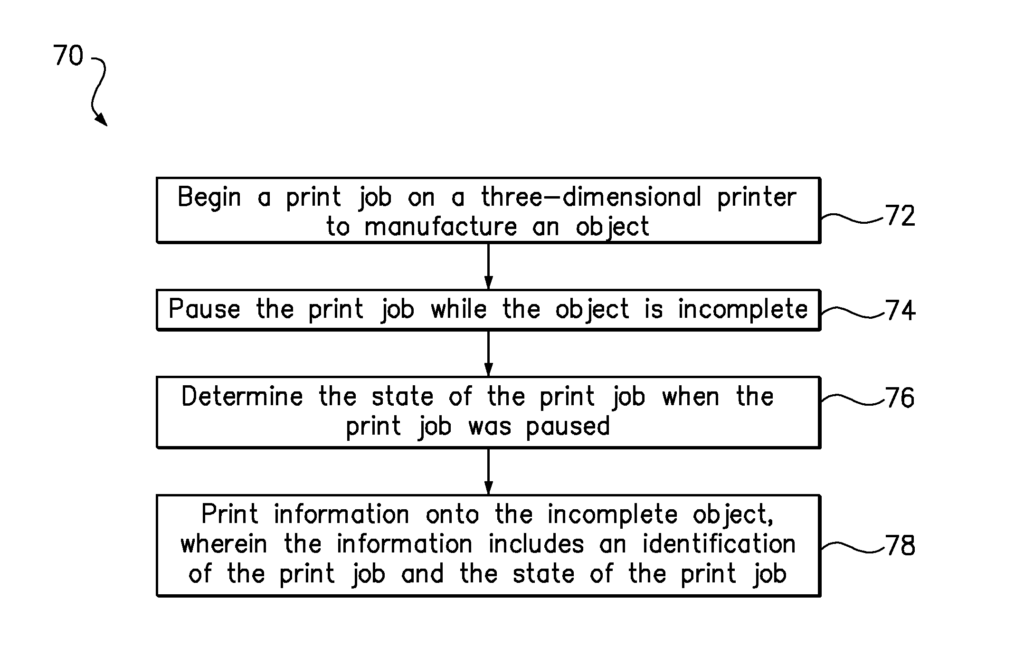
The International Business Machines Corp invention works as follows
A method that comprises starting a printjob on a 3-D printer to manufacture an item, pausing it while the object remains incomplete, determining its state when the printjob was paused and printing information on the incomplete object. The information includes identification of the job. The information is preferably in the form of a barcode matrix printed on the surface of the object.
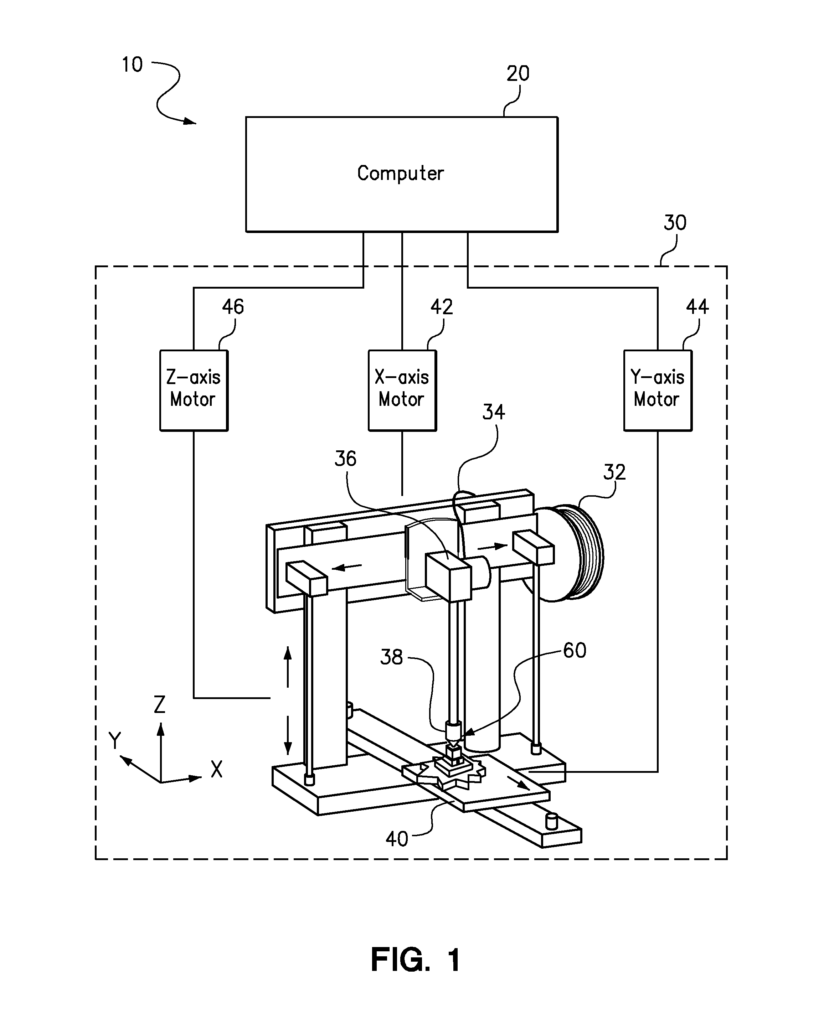
Background for Pausing and restarting a 3D printjob
1. “1.
The present invention is a method of printing three-dimensional objects.
2. “2.
Three-dimensional (3D), printing is the process of creating a three-dimensional model from a digital design using an additive method, in which successive layers of materials are laid over previous layers. Material can be a filament of thermoplastic polymer that is heated, then extruded from a narrow nozzle. The nozzle or the table that supports the material can be moved to control the deposit of the material.
3D printing has become a huge industry, with an increasing number of printer makers and websites that offer construction plans to download onto a computer. 3D printing requires more time and is more complicated than 2D. It can take hours to print objects that have a high level of detail. In an ideal world, 3D printing jobs are not started until there is sufficient time and material to finish the job. Work schedules, power failures, shortages of materials and other factors may prevent 3D printing jobs from being completed from beginning to end.
Some printers will allow you to pause and resume printing, provided you don’t move an object while it is still in progress and leave the printer running. If you accidentally move the incomplete object on the table, the rest of your print job will be out of alignment with the original part. A 3D print job can be paused to replace or change a plastic filament used to create the object, or simply to stop and finish the job later.
The present invention includes a method that comprises starting a print-job on a 3-D printer to produce an object, pausing it while the object is still incomplete, determining its state when the print-job was paused and printing information on the incomplete object.
BRIEF DESCRIPTION ABOUT THE VIEWS FROM THE DRAWINGS
FIG. “FIG.
FIG. “FIG.
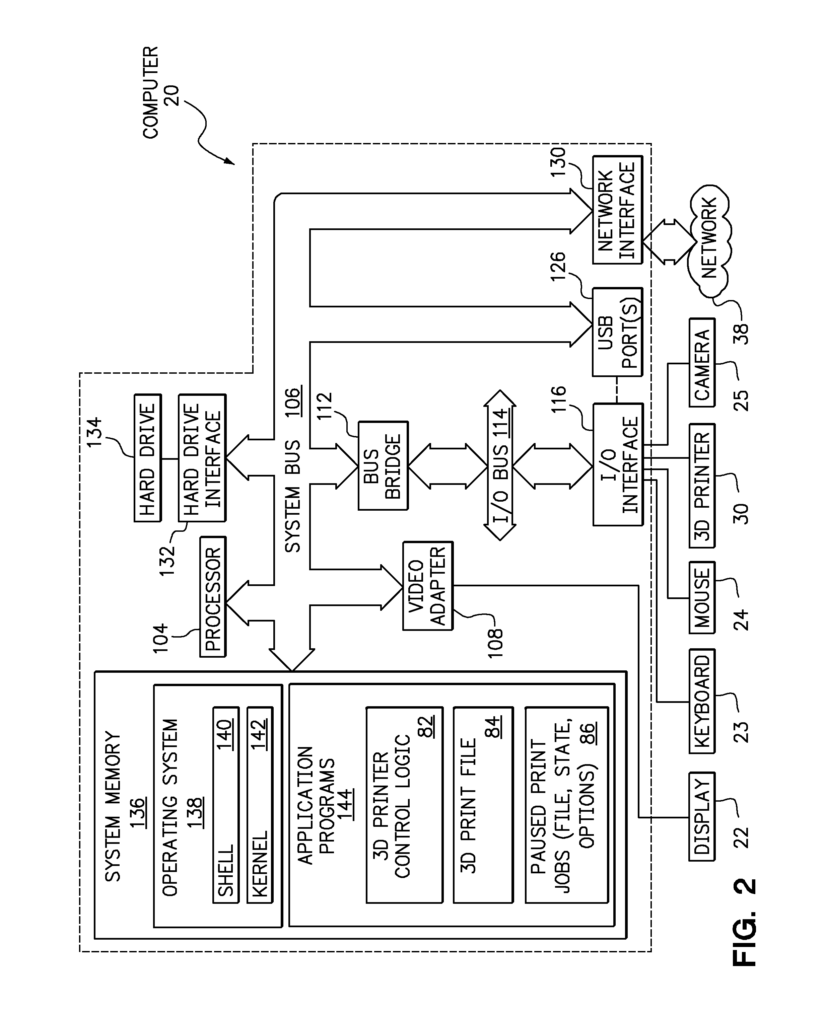
FIG. “FIG.
FIG. “FIG.
FIG. “FIG.
The present invention includes a method that comprises starting a print-job on a 3-D printer to produce an object, pausing it while the object is still incomplete, determining its state when the print-job was paused and printing information on the incomplete object.
In one alternative, the method can further include encoding the data into a barcode. (For example, a quick response barcode or matrix barcode).” Printing the barcode on the incomplete item is included in printing the information. The information can be associated with a unique identifier, such as a symbol or number, printed on the incomplete item. The unique identifier can be linked to print job information stored in an accessible record by the computer or printer. The unique identifier can then be used to search for information regarding the print job. The term barcode as used here is meant to include all types of barcodes including traditional barcodes such as UPC standard barcodes and matrix barcodes. “While a barcode can be considered a two-dimensional symbol, the printing of a code with plastic results in raised bars or portions that give it a three-dimensional appearance.
In another option, the information will be printed on the object that is incomplete in a place where it will be erased when the print job resumes. The information will not be printed on the finished object. Information can be printed using the same materials that are being used to make the object on an incomplete object. The printer will consider the raised areas on the QR code or information when the print job resumes. Another option is to print the information on an incomplete object in a way that it faces the front of the 3D printer or in such a manner or orientation that a fixed camera could read and view the information.
The information printed on the incomplete object could be sufficient to continue the print job, without having to duplicate any part of the construction. The information can include the identification of a print job as well as the state of a print job. In this case, the identification of a print job is a printfile, while the state of he print job is the point within the file where the job was paused. Print jobs are different from print files in that they are unique each time the print file is sent for printing. Print options used to print the incomplete object can also be included in the information printed on it. Print options, for example, may include the print resolution.
Alternatively, information can be printed on the incomplete object in any form of unique identifier which the computer/printer can read and associate to a record that is stored in a memory accessible by the computer/printer. The unique identifier can be selected without restriction from a barcode, a code consisting of alphabetic letters, numbers, or both. The record stored with the unique identification would also contain an identification of print file, state of print job and any print options used to print the incomplete object. The printer or computer can then use the unique identification to retrieve the record with all the necessary information to continue the print job.
In another embodiment, the information can be printed on the incomplete object periodically without a pause command. In order to be prepared in the event that the printing process is interrupted or paused, information is printed on the incomplete object at one or several stages.
The incomplete object can be removed from the 3D printer after a print job is paused. The three-dimensional printer can be used to print a second print job, before returning the object to be finished. After pausing the print and before restarting the print, the incomplete object can be subjected to other processing. Other processing can include, for example, inserting a piece into the incomplete object.
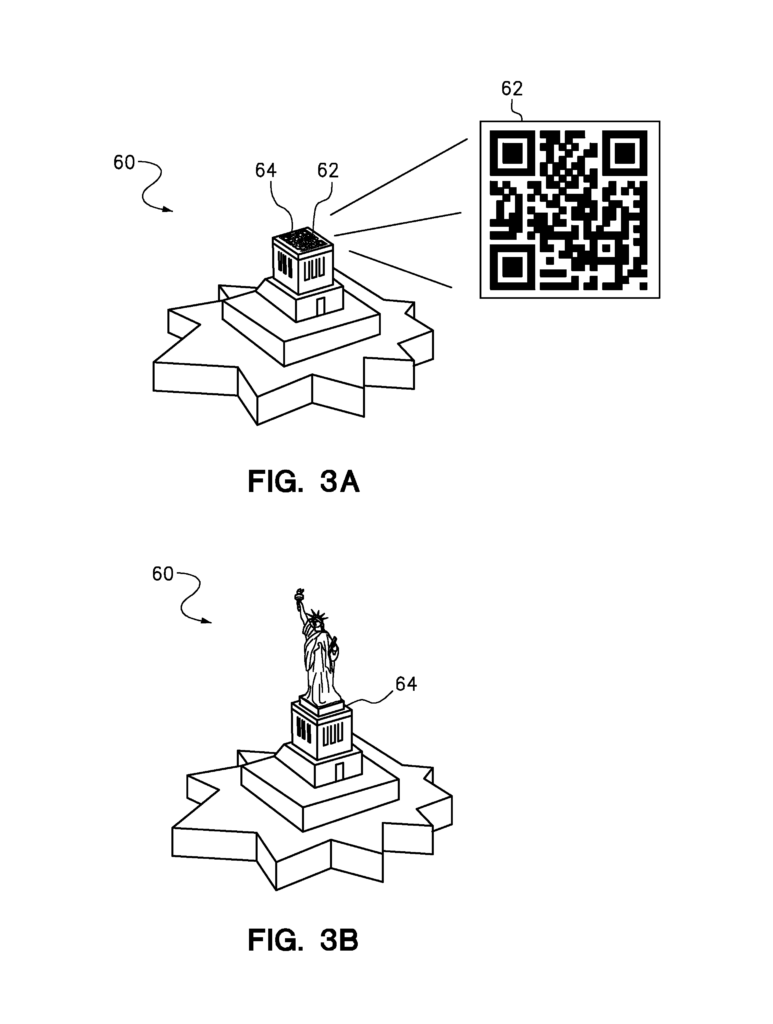
Embodiments” of the present invention can also include returning the object incomplete to the printer three-dimensional, reading the printed information on the object incomplete, and then resuming print job with the printed information on the object incomplete and a copy stored in the memory of the printer three-dimensional. Information preferably includes identification of the file, state of the file at which the job was paused and print options. The information on the incomplete object can be read using a camera that is attached to the 3D printer.
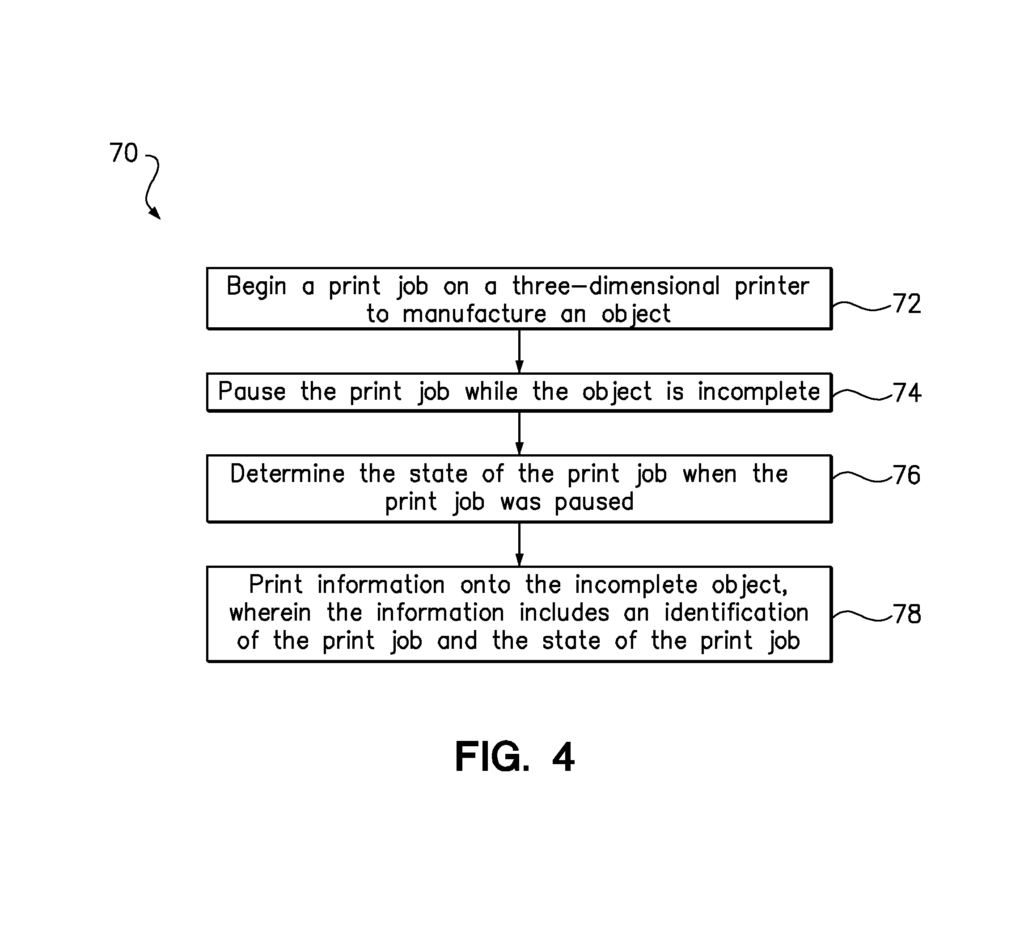
Click here to view the patent on Google Patents.
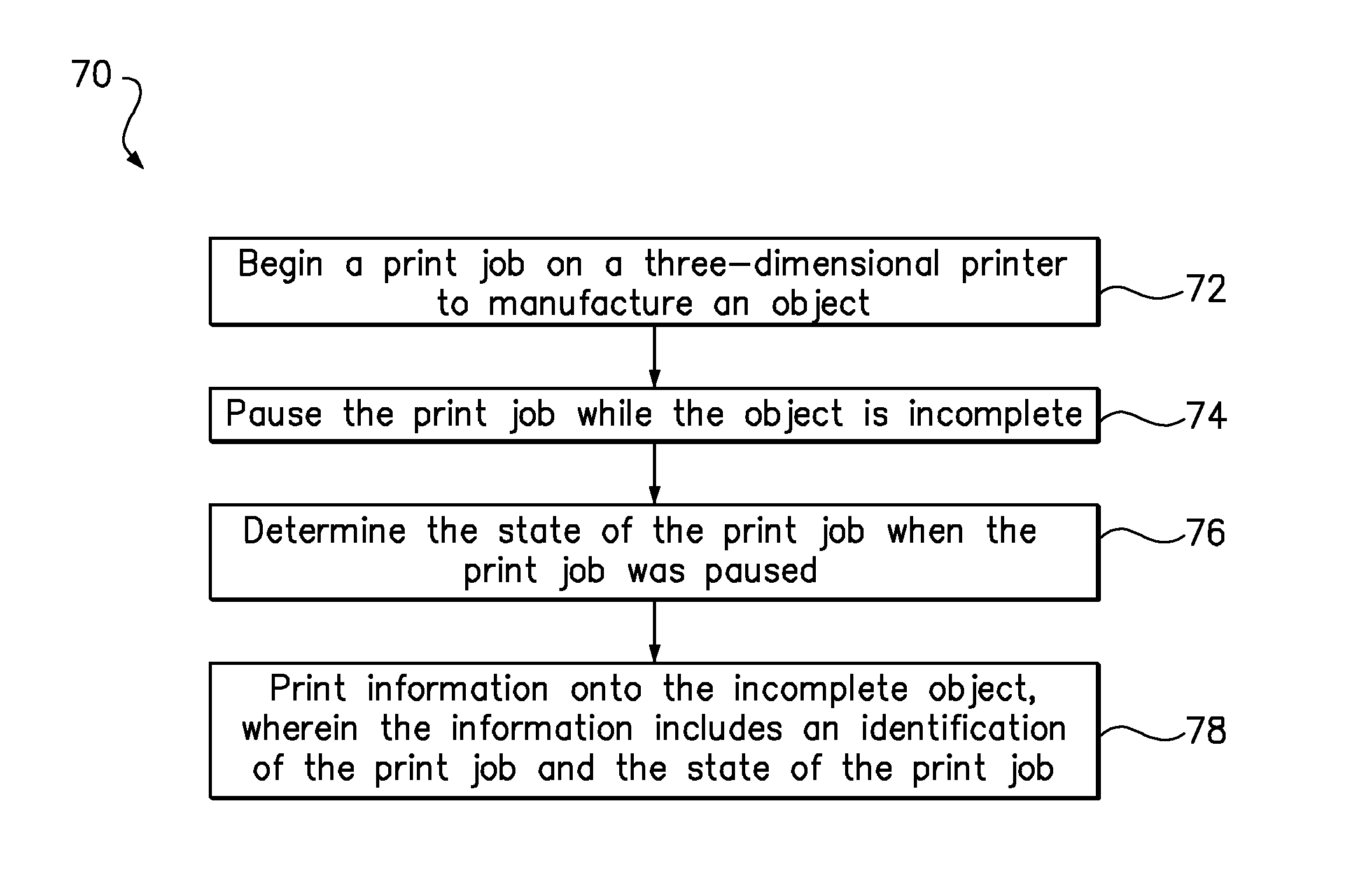
Leave a Reply